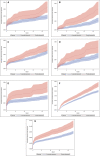Association of Prenatal Depression With New Cardiovascular Disease Within 24 Months Postpartum
- PMID: 37073814
- PMCID: PMC10227220
- DOI: 10.1161/JAHA.122.028133
Association of Prenatal Depression With New Cardiovascular Disease Within 24 Months Postpartum
Abstract
Background Although depression is well established as an independent risk factor for cardiovascular disease (CVD) in the nonpregnant population, this association has largely not been investigated in pregnant populations. We aimed to estimate the cumulative risk of new CVD in the first 24 months postpartum among pregnant individuals diagnosed with prenatal depression compared with patients without depression diagnosed during pregnancy. Methods and Results Our longitudinal population-based study included pregnant individuals with deliveries during 2007 to 2019 in the Maine Health Data Organization's All Payer Claims Data. We excluded those with prepregnancy CVD, multifetal gestations, or no continuous health insurance during pregnancy. Prenatal depression and CVD (heart failure, ischemic heart disease, arrhythmia/cardiac arrest, cardiomyopathy, cerebrovascular disease, and chronic hypertension) were identified by International Classification of Diseases, Ninth Revision (ICD-9)/International Classification of Diseases, Tenth Revision (ICD-10) codes. Cox models were used to estimate hazard ratios (HRs), adjusting for potential confounding factors. Analyses were stratified by hypertensive disorder of pregnancy. A total of 119 422 pregnancies were examined. Pregnant individuals with prenatal depression had an increased risk of ischemic heart disease, arrhythmia/cardiac arrest, cardiomyopathy, and new hypertension (adjusted HR [aHR], 1.83 [95% CI, 1.20-2.80], aHR, 1.60 [95% CI, 1.10-2.31], aHR, 1.61 [95% CI, 1.15-2.24], and aHR, 1.32 [95% CI, 1.17-1.50], respectively). When the analyses were stratified by co-occurring hypertensive disorders of pregnancy, several of these associations persisted. Conclusions The cumulative risk of a new CVD diagnosis postpartum was elevated among individuals with prenatal depression and persists even in the absence of co-occurring hypertensive disorders of pregnancy. Further research to determine the causal pathway can inform postpartum CVD preventive measures.
Keywords: arrhythmia; cardiomyopathy; cerebrovascular disease; chronic hypertension; ischemic heart disease; postpartum screening; prenatal depression.
Figures


References
-
- GBD 2013 Mortality and Causes of Death Collaborators. Global, regional, and national age‐sex specific all‐cause and cause‐specific mortality for 240 causes of death, 1990–2013: a systematic analysis for the Global Burden of Disease Study 2013. Lancet. 2015;385:117–171. doi: 10.1016/S0140-6736(14)61682-2 - DOI - PMC - PubMed
-
- Davis NL, Smoots AN, Goodman DA. Pregnancy‐Related Deaths: Data from 14 US Maternal Mortality Review Committees, 2008‐2017. Atlanta, GA: Centers for Disease Control and Prevention, U.S. Department of Health and Human Services; 2019.
Publication types
MeSH terms
Grants and funding
LinkOut - more resources
Full Text Sources
Medical

